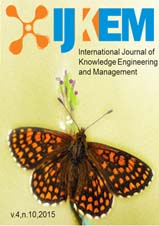Knowledge-Based System for Categorization and Selection of Creativity Support Techniques
Conteúdo do artigo principal
Resumo
Objective: In order to maintain its market share in current competitive scenario, every design organization must enhance its creativity skills, the basis to innovate and develop adequate solutions to changing costumers’ needs. A great expertise is required to reach such creativity level, a skill currently dependent on human capability. As such knowledge is subjected to availability, the development of a computational system with the capacity of selecting appropriately creativity techniques becomes relevant, emulating decision-making ability. This work aims to elucidate implemented metrics on a knowledge-based system (KBS) for asserting creativity techniques, serving as a comparison filter between typical design team’s needs and the available techniques.
Design/Methodology/Approach: Creativity tools are powerful allies in building alternative mind pathways, through which a team may develop better and more suitable ideas. Each tool has appropriate use situations, covering several aspects of the design process, organization and team profile. To assert appropriately creativity techniques, the KBS requires a logic connection between factors that lead to the choice and the actual tool selection, i.e. the system output results. Such chaining was structured in a double inference process using categorization, which describes the entry scenario in terms of five categories and matches the identified values of each category with available creativity techniques.
Results: The developed prototype is able to select adequate creativity techniques in design. The five categories aid in filtering techniques according to the design situation, reducing the selection spectrum and supporting the appropriate choice of tools. In its current version, the prototype selects among 24 creativity support techniques in a combination of more than 500 design scenarios. The outputs include explanations on the used inference process, learnings on how to use each tool, overall information and examples.
Detalhes do artigo

Este trabalho está licenciado sob uma licença Creative Commons Attribution-ShareAlike 4.0 International License.
Esta licença permite que outros remixem, adaptem e criem a partir do seu trabalho para fins não comerciais, e embora os novos trabalhos tenham de lhe atribuir o devido crédito e não possam ser usados para fins comerciais, os usuários não têm de licenciar esses trabalhos derivados sob os mesmos termos.

